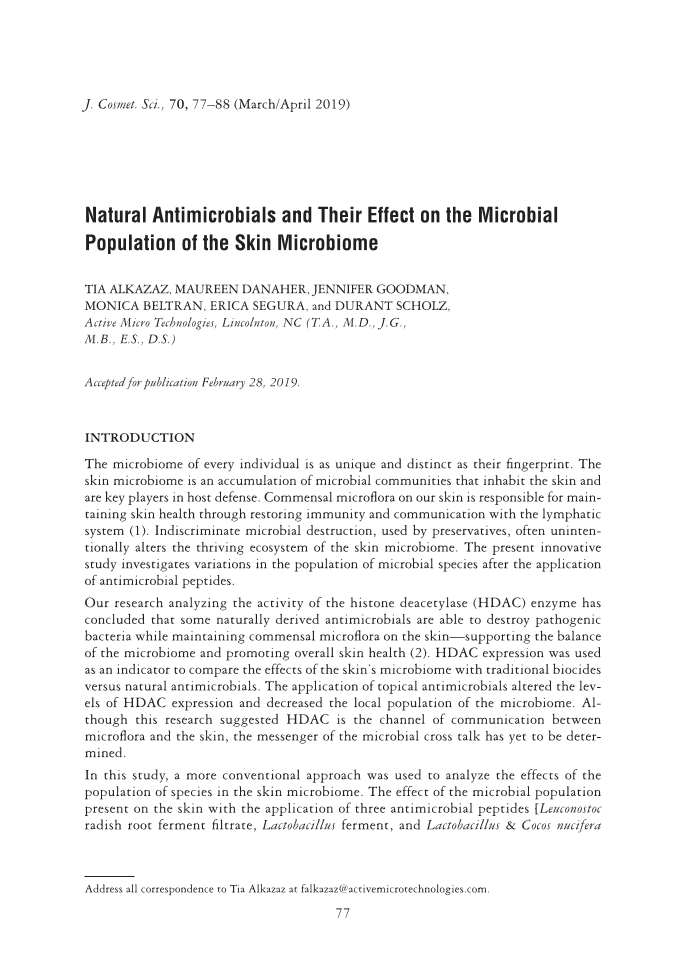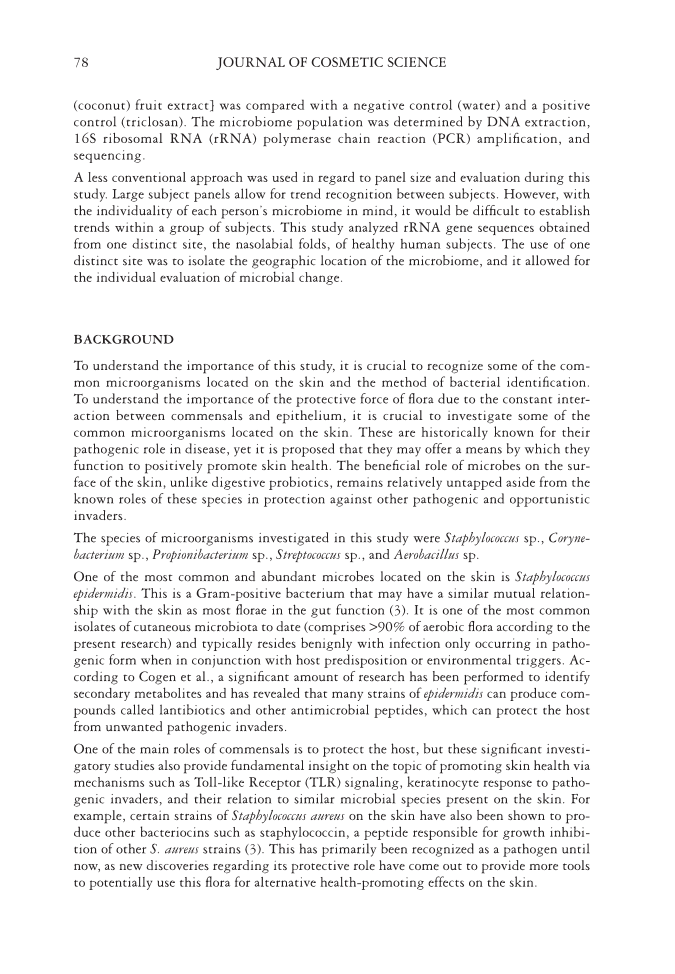J. Cosmet. Sci., 70, 77–88 (March/April 2019) 77 Natural Antimicrobials and Their Effect on the Microbial Population of the Skin Microbiome TIA ALKAZAZ, MAUREEN DANAHER, JENNIFER GOODMAN, MONICA BELTRAN, ERICA SEGURA, and DURANT SCHOLZ, Active Micro Technologies, Lincolnton, NC (T.A., M.D., J.G., M.B., E.S., D.S.) Accepted for publication February 28, 2019. INTRODUCTION The microbiome of every individual is as unique and distinct as their fi ngerprint. The skin microbiome is an accumulation of microbial communities that inhabit the skin and are key players in host defense. Commensal microfl ora on our skin is responsible for main- taining skin health through restoring immunity and communication with the lymphatic system (1). Indiscriminate microbial destruction, used by preservatives, often uninten- tionally alters the thriving ecosystem of the skin microbiome. The present innovative study investigates variations in the population of microbial species after the application of antimicrobial peptides. Our research analyzing the activity of the histone deacetylase (HDAC) enzyme has concluded that some naturally derived antimicrobials are able to destroy pathogenic bacteria while maintaining commensal microfl ora on the skin—supporting the balance of the microbiome and promoting overall skin health (2). HDAC expression was used as an indicator to compare the effects of the skin’s microbiome with traditional biocides versus natural antimicrobials. The application of topical antimicrobials altered the lev- els of HDAC expression and decreased the local population of the microbiome. Al- though this research suggested HDAC is the channel of communication between microfl ora and the skin, the messenger of the microbial cross talk has yet to be deter- mined. In this study, a more conventional approach was used to analyze the effects of the population of species in the skin microbiome. The effect of the microbial population present on the skin with the application of three antimicrobial peptides [Leuconostoc radish root ferment fi ltrate, Lactobacillus ferment, and Lactobacillus & Cocos nucifera Address all correspondence to Tia Alkazaz at falkazaz@activemicrotechnologies.com.
JOURNAL OF COSMETIC SCIENCE 78 (coconut) fruit extract] was compared with a negative control (water) and a positive control (triclosan). The microbiome population was determined by DNA extraction, 16S ribosomal RNA (rRNA) polymerase chain reaction (PCR) amplifi cation, and sequencing. A less conventional approach was used in regard to panel size and evaluation during this study. Large subject panels allow for trend recognition between subjects. However, with the individuality of each person’s microbiome in mind, it would be diffi cult to establish trends within a group of subjects. This study analyzed rRNA gene sequences obtained from one distinct site, the nasolabial folds, of healthy human subjects. The use of one distinct site was to isolate the geographic location of the microbiome, and it allowed for the individual evaluation of microbial change. BACKGROUND To understand the importance of this study, it is crucial to recognize some of the com- mon microorganisms located on the skin and the method of bacterial identifi cation. To understand the importance of the protective force of fl ora due to the constant inter- action between commensals and epithelium, it is crucial to investigate some of the common microorganisms located on the skin. These are historically known for their pathogenic role in disease, yet it is proposed that they may offer a means by which they function to positively promote skin health. The benefi cial role of microbes on the sur- face of the skin, unlike digestive probiotics, remains relatively untapped aside from the known roles of these species in protection against other pathogenic and opportunistic invaders. The species of microorganisms investigated in this study were Staphylococcus sp., Coryne- bacterium sp., Propionibacterium sp., Streptococcus sp., and Aerobacillus sp. One of the most common and abundant microbes located on the skin is Staphylococcus epidermidis. This is a Gram-positive bacterium that may have a similar mutual relation- ship with the skin as most fl orae in the gut function (3). It is one of the most common isolates of cutaneous microbiota to date (comprises 90% of aerobic fl ora according to the present research) and typically resides benignly with infection only occurring in patho- genic form when in conjunction with host predisposition or environmental triggers. Ac- cording to Cogen et al., a signifi cant amount of research has been performed to identify secondary metabolites and has revealed that many strains of epidermidis can produce com- pounds called lantibiotics and other antimicrobial peptides, which can protect the host from unwanted pathogenic invaders. One of the main roles of commensals is to protect the host, but these signifi cant investi- gatory studies also provide fundamental insight on the topic of promoting skin health via mechanisms such as Toll-like Receptor (TLR) signaling, keratinocyte response to patho- genic invaders, and their relation to similar microbial species present on the skin. For example, certain strains of Staphylococcus aureus on the skin have also been shown to pro- duce other bacteriocins such as staphylococcin, a peptide responsible for growth inhibi- tion of other S. aureus strains (3). This has primarily been recognized as a pathogen until now, as new discoveries regarding its protective role have come out to provide more tools to potentially use this fl ora for alternative health-promoting effects on the skin.
Purchased for the exclusive use of nofirst nolast (unknown) From: SCC Media Library & Resource Center (library.scconline.org)

















































